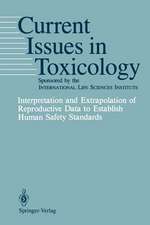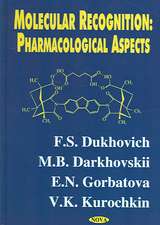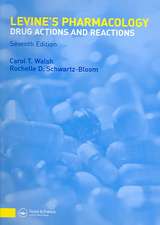Drug-Induced Liver Toxicity: Methods in Pharmacology and Toxicology
Editat de Minjun Chen, Yvonne Willen Limba Engleză Hardback – 21 mar 2018
Authoritative and practical, Drug-InducedLiver Toxicity serves all those who aim to improve assessment and understanding of hepatotoxic potentials of new medications and marketed drugs.
Chapter 30 is open access under a CC BY 4.0 license via link.springer.com.
| Toate formatele și edițiile | Preț | Express |
|---|---|---|
| Paperback (1) | 642.13 lei 38-45 zile | |
| Springer – 10 dec 2019 | 642.13 lei 38-45 zile | |
| Hardback (1) | 944.48 lei 6-8 săpt. | |
| Springer – 21 mar 2018 | 944.48 lei 6-8 săpt. |
Din seria Methods in Pharmacology and Toxicology
- 5%
 Preț: 1114.91 lei
Preț: 1114.91 lei - 5%
 Preț: 1120.40 lei
Preț: 1120.40 lei - 5%
 Preț: 1310.03 lei
Preț: 1310.03 lei - 5%
 Preț: 709.11 lei
Preț: 709.11 lei - 5%
 Preț: 1049.82 lei
Preț: 1049.82 lei - 5%
 Preț: 1058.25 lei
Preț: 1058.25 lei - 5%
 Preț: 1114.91 lei
Preț: 1114.91 lei - 5%
 Preț: 1106.69 lei
Preț: 1106.69 lei - 5%
 Preț: 1631.16 lei
Preț: 1631.16 lei - 5%
 Preț: 1042.29 lei
Preț: 1042.29 lei - 5%
 Preț: 732.36 lei
Preț: 732.36 lei - 5%
 Preț: 1042.69 lei
Preț: 1042.69 lei - 5%
 Preț: 1632.41 lei
Preț: 1632.41 lei - 5%
 Preț: 1120.55 lei
Preț: 1120.55 lei - 5%
 Preț: 1362.85 lei
Preț: 1362.85 lei - 5%
 Preț: 704.74 lei
Preț: 704.74 lei - 5%
 Preț: 1010.07 lei
Preț: 1010.07 lei - 5%
 Preț: 859.82 lei
Preț: 859.82 lei - 5%
 Preț: 1133.18 lei
Preț: 1133.18 lei - 5%
 Preț: 728.52 lei
Preț: 728.52 lei - 5%
 Preț: 708.41 lei
Preț: 708.41 lei - 5%
 Preț: 731.64 lei
Preț: 731.64 lei - 5%
 Preț: 1106.69 lei
Preț: 1106.69 lei - 5%
 Preț: 735.46 lei
Preț: 735.46 lei - 5%
 Preț: 722.48 lei
Preț: 722.48 lei - 5%
 Preț: 1306.92 lei
Preț: 1306.92 lei - 5%
 Preț: 1123.33 lei
Preț: 1123.33 lei - 5%
 Preț: 735.83 lei
Preț: 735.83 lei - 5%
 Preț: 1109.08 lei
Preț: 1109.08 lei - 5%
 Preț: 727.44 lei
Preț: 727.44 lei - 5%
 Preț: 724.50 lei
Preț: 724.50 lei - 5%
 Preț: 1116.94 lei
Preț: 1116.94 lei - 5%
 Preț: 1045.42 lei
Preț: 1045.42 lei
Preț: 944.48 lei
Preț vechi: 994.18 lei
-5% Nou
Puncte Express: 1417
Preț estimativ în valută:
180.73€ • 193.26$ • 150.69£
180.73€ • 193.26$ • 150.69£
Carte tipărită la comandă
Livrare economică 18 aprilie-02 mai
Preluare comenzi: 021 569.72.76
Specificații
ISBN-13: 9781493976768
ISBN-10: 1493976761
Pagini: 564
Ilustrații: XX, 667 p. 119 illus., 70 illus. in color.
Dimensiuni: 178 x 254 x 46 mm
Greutate: 1.4 kg
Ediția:1st ed. 2018
Editura: Springer
Colecția Humana
Seria Methods in Pharmacology and Toxicology
Locul publicării:New York, NY, United States
ISBN-10: 1493976761
Pagini: 564
Ilustrații: XX, 667 p. 119 illus., 70 illus. in color.
Dimensiuni: 178 x 254 x 46 mm
Greutate: 1.4 kg
Ediția:1st ed. 2018
Editura: Springer
Colecția Humana
Seria Methods in Pharmacology and Toxicology
Locul publicării:New York, NY, United States
Cuprins
Overview of Mechanisms of Drug-Induced Liver Injury (DILI) and Key Challenges in DILI Research.- Detection, Elimination, Mitigation, and Prediction of Drug-Induced Liver Injury in Drug Discovery.- Drug-Induced Liver Injury (DILI) Classification and Its Application on Human DILI Risk Prediction.- Physicochemical Properties and Structural Alerts.- Quantitative Structure-Activity Relationship Models for Predicting Risk of Drug-Induced Liver Injury in Humans.- An Introduction to DILIsym® Software, a Mechanistic Mathematical Representation of Drug-Induced Liver Injury.- Prediction of Human Liver Toxicity Using In Vitro Assays: Limitations and Opportunities.- Use of Liver-Derived Cell Lines for the Study of Drug-Induced Liver Injury.- Evaluation of Drug-induced Liver Injuries (DILI) with Human Hepatocytes: Scientific Rationale and Experimental Approaches.- Status and Use of Induced Pluripotent Stem Cells (iPSCs) in Toxicity Testing.- Engineered Human Liver Co-Culturesfor Investigating Drug-Induced Liver Injury.- Status and Future of 3D Cell Culture in Toxicity Testing.- Reactive Metabolite Assessment in Drug Discovery and Development in Support of Safe Drug Design.- In Vitro Assessment of Mitochondrial Toxicity to Predict Drug-Induced Liver Injury.- Bile Salt Export Pump: Drug-Induced Liver Injury and Assessment Approaches.- High Content Screening for Prediction of Human Drug-Induced Liver Injury.- Interpretation, Integration, and Implementation of In Vitro Assay Data: The Predictive Toxicity Challenge.- Perspectives on the Regulatory and Clinical Science of Drug-Induced Liver Injury (DILI).- Regulatory Toxicological Studies: Identifying Drug-Induced Liver Injury Using Nonclinical Studies.- Hy’s Law and eDISH for Clinical Studies.- Variability in Baseline Liver Test Values in Clinical Trials: Challenges in Enhancing Drug-Induced Liver Injury Assessment in Subjects with Liver Disease.- Postmarketing Surveillance of Drug-Induced Liver Injury.- HostRisk Modifiers in Idiosyncratic Drug-Induced Liver Injury (DILI) and Its Interplay with Drug Properties.- Human Leukocyte Antigen (HLA) and Other Genetic Risk Factors in Drug-Induced Liver Injury (DILI).- Immune Mechanisms in Drug-Induced Liver Injury.- Translational and Mechanistic Biomarkers of Drug-Induced Liver Injury.- Causality Assessment Methods in Drug-Induced Liver Injury.- Circulating MicroRNAs as Novel Biomarkers of Drug-Induced Liver Injury in Humans.- Systems Microscopy Approaches in Unraveling and Predicting Drug-Induced Liver Injury (DILI).- Non-Invasive Pre-Clinical and Clinical Imaging of Liver Transporter Function Relevant to Drug-Induced Liver Injury.
Textul de pe ultima copertă
This book provides a comprehensive view of the methodologies used for the study of liver toxicity encountered throughout the whole life cycle of a drug, from drug discovery, to clinical trial, post-marketing, and even clinical practice. Organized into six sections, the first section introduces the mechanisms contributing to drug-induced liver toxicity. The second and third section explore in silico and in vitro approaches used to help mitigate hepatotoxicity liability at the early stages of drug development. The fourth section describes methodologies applied in regulatory processes, including preclinical studies, clinical trials, and post-marketing surveillance. The fifth section discusses clinical hepatotoxicity. Emerging technologies are examined in the final section. As a volume in the Methods in Pharmacology and Toxicology series, chapters include the kind of expert advice that will lead to optimal results.
Authoritative and practical, Drug-Induced Liver Toxicity serves all those who aim to improve assessment and understanding of hepatotoxic potentials of new medications and marketed drugs.
Chapter 30 is open access under a CC BY 4.0 license via link.springer.com.
Caracteristici
Includes cutting-edge techniques for the study of DILI Contains key implementation advice from the experts Features detail essential for labs, from basic research through to clinical action










